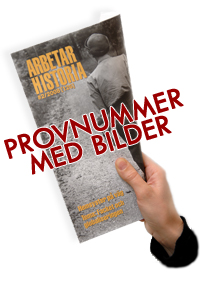Abstracts for issue no 138-139
Makten och människovärdet. Gruvstrejken 1969 som samhällskritik / Lars Ekdahl
In December 1969 the workers at the state-owned mining company LKAB in the north of Sweden went on strike. Starting as a conflict about wages and working conditions in the mines, the strike posed more general questions concerning the distribution of power in working life and in society. Ultimately, the strike could be seen as challenge to vital aspects of the Swedish model, which at the time was widely celebrated. The strike articulated a critique not only of centrally coordinated wage negotiations, solidaristic wage policy and the concentration of power and ownership in Swedish industry, but also of the intensification of work and the powerlessness of employees in the workplace. The article, which is a revised version of a lecture, is an attempt to put the strike in a historical perspective.
Med betongen som argument. De australiensiska byggnadsarbetarna samhällsengagerade verksamhet / Verity Burgmann
Between 1971 and 1975, construction workers in Australia organised in the New South Wales branch of the Builders Labourers’ Federation engaged in strikes (”bans” in Australian industrial terminology) to prevent ecologically damaging development and in support of other radical causes, such as women’s liberation, homosexual liberation and indigenous rights. Proclaiming the principle of ‘the social responsibility of labour’, this union became especially famous for its “green bans” that halted huge development projects. This union prefigures the development of ‘social-movement unionism’ from the 1990s onwards in its militancy, ultra-democratic forms of organisation, its agenda for radical social and economic change, its determination to overcome working-class fragmentation and its capacity to lead community struggles.
Det kollektiva våldets gränser. Möllevångskravallerna i Malmö 1926 / Stefan Nyzell
During a few days at the end of November 1926, the Möllevången neighborhood in Malmö was the scene of violent confrontations between thousands of demonstrators and a large part of the city police force. Behind these demonstrations lay an industrial conflict, begun early in July that year at A W Nilsson factory. The workers went on strike, and a week or so later the factory owner employed a local recruiter of strike-breakers. From the very first, trouble arose whenever there was an encounter between the strike-breakers and the striking workers. In November large scale demonstration against strike-breaking led into the Möllevången riots. The strike at A W Nilsson factory was not the only conflict in Malmö at this time where the employer used strike-breakers, the encounters between these and the striking workers causing violent confrontations. Nor did such confrontations occur only in Malmö during the interwar period. The purpose of this article is to discuss the boundaries of violent contention within industrial conflict in inter-war Sweden
Storkonflikten 1980 och andra stora arbetskonflikter i Sverige / Anders Kjellberg
The Great Conflict of 1980 and other major labour conflicts in Sweden Depending on how they are measured, either the great conflict of 1980, the general strike of 1909 or the 1945 metalworkers’ strike could lay claim to be the largest labour conflict in Sweden. The 1909 LO strike and the 1980 SAF lockout both aimed at pressing the government to act, but failed. The SAF 1980 proposals for a wage freeze and a downsized public sector were conspicuous components of a strategy to change the rules of collective bargaining. After the 1980 failure, SAF adopted decentralized wage formation as a means to radically gear down wage increases.
Att kartlägga sjuksköterskornas militans. Politiseringen av vården, det offentliga stödet och strejkerna / Linda Briskin
In recent decades, nurses have gone on strike in large numbers and in many countries. They have also used innovative non-strike tactics of resistance such as mass resignations. This article explores nurse militancy through strike narratives. It argues that in recent decades, the professional commitments of nurses to the provision of care have confronted health care restructuring, nursing shortages, intensification of work, precarious employment and gendered hierarchies with a militant discourse around the public interest, and a reconstitution and reclamation of caring work, what I call the politicization of caring. This research suggests that nurses’ dedication to caring work may now encourage rather than dissuade them from going on strike. It also highlights the widespread public support for nurses, even when they go on strike illegally.
Finally, nurse militancy challenges commonsense miscon¬ceptions that women workers are passive and unlikely to strike. It problematizes the associations of militancy with men, masculinity and manliness. In fact, in its capacity to build public support, nurse militancy helps to mainstream and legitimize militancy itself. Nurse militancy and coalition-building are part of a long tradition of union women’s organizing and resistance which may provide untapped potential to defend public services, protect workers’ rights, and invigorate the union renewal project.


